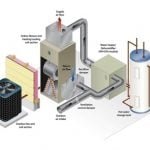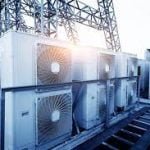As an HVAC Expert, I have been asked this question several times:” What are the common HVAC Mistakes?”. HVAC stands for heating, ventilation, and air conditioning. It is the system that regulates the temperature and air quality of your home or building. A well-functioning HVAC system can provide comfort, energy efficiency, and health benefits. However, many people make common HVAC mistakes that can affect the performance and lifespan of their system, as well as increase their energy bills and repair costs. This blog post will discuss 11 of the most common HVAC mistakes and how to avoid them.
Most Common HVAC Mistakes To Avoid
- Neglecting Regular Maintenance
- Choosing the Wrong Size or Type of HVAC System
- Setting the Thermostat Incorrectly
- Closing or Blocking Vents and Registers
- Ignoring Strange Noises or Smells
- Using the Wrong Refrigerant
- Installing the Outdoor Unit in the Wrong Place
- Forgetting to Replace the Batteries in the Thermostat
- Using the Wrong Air Filter
- Running the Fan Continuously
- DIYing the Installation, Repair, or Replacement of Your HVAC System
Mistake #1: Neglecting Regular Maintenance
One of the most common HVAC mistakes is paying attention to regular maintenance. Periodic check-ups and tune-ups are crucial for a smooth, efficient system. Without proper upkeep, your HVAC may suffer wear, dirt accumulation, leaks, and other issues leading to reduced efficiency and breakdowns. According to the U.S. Department of Energy, regular maintenance can save up to 30% on energy bills.
Prevention
- Schedule annual HVAC maintenance, ideally before the heating or cooling season.
- Change or clean air filters monthly or as the manufacturer recommends to improve indoor air quality and prevent system issues.
- Inspect ducts, vents, and the outdoor unit for damage or blockage, cleaning as needed.
- A dirty filter reduces airflow efficiency and increases allergy and respiratory risks.
Mistake #2: Choosing the Wrong Size or Type of HVAC System
Another common HVAC mistake is choosing the wrong size or type of HVAC system for your home or building. Your HVAC choice depends on space size, layout, climate, insulation, ventilation, and personal preferences. Optimal comfort and efficiency require avoiding too small or too large systems. Undersized systems demand extra support, causing uneven temperatures, high energy use, and frequent cycling. Oversized systems waste energy, induce high humidity, and cycle too quickly, leading to increased wear, higher bills, and reduced lifespan.
Don’t Forget to Learn more about Types Of Furnace Ignitors: An In-Depth Guide
Prevention
- Consult a professional HVAC contractor to determine the right system size and type.
- They can conduct a load calculation based on various factors to estimate your space’s heating or cooling needs.
- This helps you select a system that matches your load, ensuring peak performance and efficiency.
- Consider available HVAC types like central, split, ductless, heat pump, or geothermal.
- Choose one that fits your space and budget.
Mistake #3: Setting the Thermostat Incorrectly
A third HVAC mistake is thermostat mismanagement. The thermostat regulates the HVAC system temperature and operation. Incorrect settings, either too high, too low, or frequent adjustments, impact system comfort and efficiency. Extreme settings force the system to overwork, increasing energy consumption and lowering comfort. Regular adjustments cause the system to cycle excessively, reducing efficiency and lifespan.
Prevention
Here are the steps to follow for maintaining a consistent, comfortable temperature and saving up to 10% on yearly energy bills:
- Set the thermostat at a constant temperature that meets your heating or cooling needs.
- The U.S. Department of Energy recommends setting the thermostat at 78°F in summer and 68°F in winter when home.
- Adjust the temperature by 10-15 degrees when away or asleep.
- Minimize thermostat adjustments to maintain system balance and efficiency.
- Consider a programmable or smart thermostat for automated temperature adjustments based on your schedule and preferences, providing convenience and control.
Common HVAC Mistake #4 – Closing or Blocking Vents and Registers
The fourth common HVAC mistake is closing or blocking vents and registers, openings facilitating air circulation. Some erroneously believe this conserves energy and money. However, it creates pressure imbalances, reducing system efficiency and performance, causing uneven temperatures, poor air quality, and duct and equipment damage.
Don’t Forget to Read More about Furnace Gas Valve Leaking: How To Fix It ?
Prevention
- To ensure proper airflow and maintain system efficiency, follow these steps:
- Keep vents and registers open and clear of obstructions like furniture, curtains, or rugs.
- Ensure free and even airflow by maintaining system balance.
- Keep vents and registers clean to enhance indoor air quality and prevent allergens and pollutants from entering the system.
Mistake #5: Ignoring Strange Noises or Smells
The fifth HVAC mistake is neglecting unusual system noises or smells. An efficiently operating HVAC system should be quiet and odor-free. Strange sounds like banging, squealing, or hissing, and unusual smells like burning or mustiness indicate potential problems. Ignoring these signs may lead to more significant damage and costly repairs and compromise your comfort and safety.
Prevention
To prevent HVAC problems, follow these steps:
1. promptly Address strange noises or smells by contacting a professional HVAC contractor.
2. Schedule an inspection of your system to diagnose issues accurately.
3. Consider appropriate solutions to fix problems such as loose parts, electrical problems, refrigerant leaks, mold growth, and pest infestation.
4. Timely resolution prevents further complications and protects your system and health.
HVAC Mistake #6- Using the Wrong Refrigerant
The sixth common HVAC mistake involves using the wrong refrigerant for your system. Refrigerants absorb and release heat, enabling the cooling process. Different types like R-22, R-410A, R-32, and R-134a have specific specifications and compatibilities. Using the wrong refrigerant can lead to reduced efficiency, increased energy consumption, poor performance, and equipment damage. It may also harm the environment, violating EPA regulations.
Prevention
To avoid this mistake:
- Use the manufacturer-specified refrigerant and regularly check and replenish levels.
- Never mix refrigerant types, as it can damage the system and pose safety hazards.
- Hire a certified HVAC contractor to handle refrigerants, following proper procedures and guidelines for refrigerant management.
Mistake #7: Installing the Outdoor Unit in the Wrong Place
The seventh common HVAC mistake is improper outdoor unit installation. The outdoor unit, or condenser unit, releases refrigerant heat to the outside air. Incorrect placement exposes it to extreme temperatures, sunlight, rain, snow, wind, and debris, impacting efficiency, performance, durability, and lifespan.
Prevention.
To avoid this mistake:
- Install the outdoor unit in a shaded, level, well-ventilated area.
- Please keep it away from heat sources and moisture and ensure proper clearance to allow unrestricted airflow, preventing blockages or overheating.
- Shield it from physical damage and clean it regularly to remove dirt or debris.
Mistake #8: Forgetting to Replace the Batteries in the Thermostat
The eighth common HVAC mistake is forgetting to replace thermostat batteries. The thermostat controls the HVAC system temperature and operation, relying on batteries for proper functioning. Low or dead batteries prevent communication with the system, leading to heating or cooling issues, inaccurate readings, and erratic behavior.
Prevention
To avoid this mistake, replace thermostat batteries annually or as the manufacturer recommends. Regularly check battery levels to ensure continuous system operation.
Mistake #9: Using the Wrong Air Filter
The ninth common HVAC mistake is using the wrong air filter. Air filters enhance indoor air quality, preventing dust and debris from entering your system. However, using the faulty filter can impact system efficiency, performance, and health. Filters like fiberglass, pleated, electrostatic, or HEPA vary in rating and specifications. Incorrect filters reduce airflow and efficiency and raise the risk of allergies and respiratory problems.
Don’t Forget to Read More about VAV Vs AHU: Understanding The Difference
Prevention
- Use the specified air filter to avoid mistakes.
- Check the Minimum Efficiency Reporting Value (MERV) rating.
- A higher MERV rating indicates better particle removal.
- Avoid filters with a higher MERV rating than your system can handle, which may decrease airflow.
- Regularly replace or clean the air filter, at least monthly, to prevent clogging or contamination.
Mistake #10: Running the Fan Continuously
The tenth HVAC mistake is running the fan continuously, thinking it improves air quality and comfort. Continuous operation wastes energy increases costs, and poses system and health risks. It elevates energy consumption, wears out the fan motor, and generates more dust and humidity, affecting air quality, mold growth, and allergies.
Prevention
To optimize your fan usage and avoid mistakes, follow these steps:
- Run the fan only when heating or cooling your space
- Turn the fan off during system inactivity
- Use the fan’s auto mode for temperature-based operation.
- This optimizes airflow and comfort while saving energy and extending the fan’s lifespan.
Mistake #11: DIYing the Installation, Repair, or Replacement of Your HVAC System
DIY installation, repair, or replacement is the eleventh and final common HVAC mistake. HVAC systems require professional knowledge, and DIY attempts can be dangerous, costly, void warranties, and violate codes. DIY risks include electrical shocks, gas leaks, fire hazards, system damage, property damage, and compromised efficiency. DIY may void warranties and violate codes and regulations, leading to fines and penalties.
Prevention
When it comes to HVAC services, here are some benefits of working with a professional:
- Ensures safe and high-quality services
- Adherence to standards, codes, and regulations
- Provides warranties and guarantees
- Helps you meet HVAC system requirements
Common HVAC Mistakes ~ Conclusion
Avoid these 11 common HVAC mistakes for smooth and efficient system functioning, saving money and energy, and improving indoor air quality and comfort. We’re [HVAC Experts], a reliable and professional HVAC contractor providing affordable, high-quality installation, maintenance, repair, and replacement services. Get in touch with us today for your HVAC needs.





